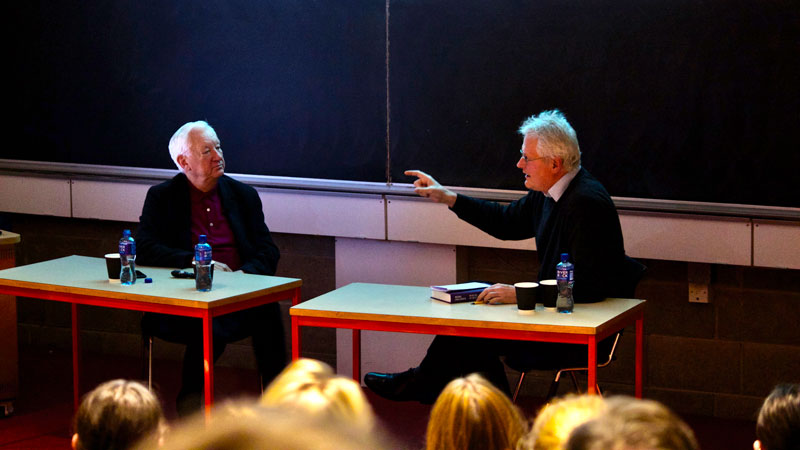Last night, Irish-born artist Michael Craig-Martin spoke to the Trinity Irish Art Research Centre and Trinity Visual Arts Society (VisArts) in a talk entitled “from the Fountain to an Oak Tree”. The event marks the first of a series to celebrate Trinity Irish Art Research Centre’s 15th anniversary. Linda Doyle, Director at Connect and the Chair of centre, offered opening remarks. “It’s a great honour to be here and to be launching this. I must say I find it utterly fascinating to hear people speak about their work”, she said.
The event took the format of a talk between Sean Rainbird, Director of the National Gallery of Ireland and Craig-Martin, leaving plenty of room for questions and conversation. Craig-Martin began by showing the audience a selection of images of his oeuvre from his works. Marking the centenary of Marcel Duchamp’s “Fountain”, Craig-Martin discussed the importance of this seminal artwork in the development of his own works. The first work he showed the audience juxtaposed Rietveld’s chair with Duchamp’s “Fountain” of the same year, explaining: “If you wanted to sum up the 20th century in two things, you could hardly find better.” He continued by showing the audience his works that were inspired by Duchamp, ranging from a series of large-scale wall paintings to colourful and dynamic prints. Interestingly, he stated: “I took his work that was anti-paintings and turned them into paintings.”
He further expressed his admiration for Duchamp, explaining that “Duchamp is the person who implied that it’s possible to be an expressive artist without painting” and that through his work “he legitimized different venues”. In her introduction, Yvonne Scott, the director of the centre, drew comparisons between Duchamp and Craig-Martin, explaining that they had both been identified as the father of conceptualism.
Rainbird and the artist discussed Craig-Martin’s seminal work, “An Oak Tree”. A work comprised of two elements: a half-full glass of water sitting on a a simple white shelf accompanied by a framed notice offering potential questions and answers a viewer might have when looking at the work. The artist explained he “thought of every question anybody could put to me” and offered answers concerning the absolute work. Like Duchamp’s “Fountain”, it’s a readymade and it’s impossible not to draw ties between these works and those by Duchamp.
The back-and-forth conversation between Craig-Martin and Rainbird created a casual, relaxed atmosphere, and when the floor was finally opened to questions, several arms immediately shot up in the air, which is a testament to the engaging discussion between Craig-Martin and Rainford. One member of the audience asked about the art world in the 21st century. Craig-Martin explained that “we now live in a world where there is no orthodoxy. It is out of the question to be radical. You have to be radical in relation to something that won’t accept it. In a certain sense, it diminishes everything”.
Another member of the audience asked: “Is it true that you had to argue that the oak tree wasn’t an oak tree because of customs?”, which led the audience to erupt with laughter. Craig-Martin confirmed this rumour, explaining that customs said to him, “You can’t bring this in because it’s vegetation, and you can’t bring vegetation into Australia. And then I had to explain to them that it’s just an empty glass”.
The well attended event, offered an unique insight into the artist’s career and created a space for the audience to hear Craig-Martin passionately discuss his work in an intimate setting.







